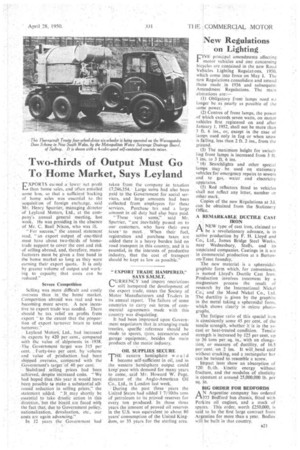New Regulations • on Lighting
Page 55

If you've noticed an error in this article please click here to report it so we can fix it.
rIVE principal amendments affecting
motor vehicles and one concerning bicycles are contained in the new Road Vehicles Lighting Regulations, 1950, which come into force on May 1. The new Regulations consolidate and amend those made in 1936 and subsequent Amendment Regulations. The main alterations are:—
(1) Obligatory front lamps need no longer be as 'nearly as possible of the same power.
(2) Centres of front lamps, the power of which exceeds seven watts, on motor vehicles first registered on and after January 1, 1952, shall not be more than 3 ft. 6 ins., or, except in the case of lamps used only in fog or when snow is falling, less than 2 ft. 2 ins., from the
ground. .
(3) The maximum height for 'swivelhng front lamps is increased from 3 ft. 3 ins. to 3 ft. 6 ins.
° (4) Searchlights and other special lamps may be used on stationary vehicles for emergency repairs to sewers and to gas, water and electricity apparatus. '
(5) Red reflectors fitted to vehicles shall not reflect any letter, number or other mark.
Copies of the new Regulations at 3d. coarrc nebe obtained from the Stationery A REMARKABLE DUCTILE CAST IRON ANEW type of cast iron, claimed to be a revolutionary advance, is in active production by F. H. Lloyd and Co., Ltd., James Bridge Steel Works, near Wednesbury, Staffs, and its associated companies. Castings in it are in commercial production at a Burtonon-Trent foundry, The new material is a spheroidalgraphite form which, for convenience, is named Lloyd's Ductile Cast Iron. Production involves treatment by a magnesium process the result of research by the International Nickel Co., arid the Mond Nickel Co., Ltd. The ductility is given by the graphite in the metal taking a spheroidal form, which shows clearly in 'micro photographs.
The fatigue ratio of this special iron is consistently some 45 per cent, of the tensile strength, whether it is in the ascast or heat-treated condition. Tensile strength is increased by 125 per cent, up to 36 tons per sq. in., with an elongation, or measure of ductility, of 16.5 per cent, on 2 ins. It will bend cold without cracking, and a rectangular bar • can be twisted to resemble a screw.
Impact tests show an absorption of 120 ft.-lb. kinetic energy without fracture, and themodulus of elasticity is constant at around 25,000,000 lb. per sq. in.
• BIG ORDER FOR BEDFORDS
AN Argentine company has ordered 375 Bedford bus chassis, fitted with Perkins oil engines, and a stock of spares.. This order, worth £250,000, Ti said to be the first large contract from Argentina for more than a year. Bodies will be built in that country.




































































































































































































